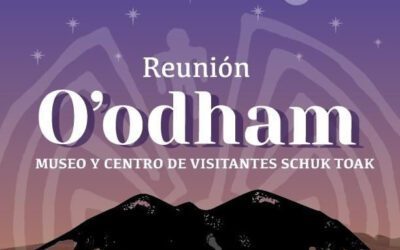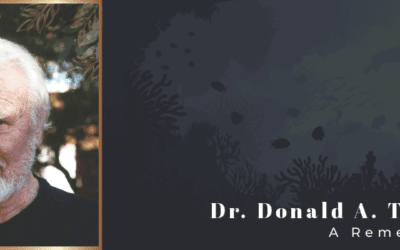[vc_row][vc_column][vc_separator][vc_column_text]By: Doug Duncan; U.S. Fish and Wildlife Service[/vc_column_text][/vc_column][/vc_row][vc_row][vc_column width=”2/3″][vc_column_text]It takes active partnerships to achieve conservation that is meaningful and lasting. When I started my conservation career more than 30 years ago, I was like most biologists then, and just wanted to work with animals and be outdoors. But I now realize partnerships with many people and groups not only make impactful conservation happen, it is much more personally and professionally fulfilling to work that way.
Such an active conservation partnership exists, saving the native fishes of the Rio Sonoyta. The endangered Sonoyta Pupfish Cyprinodon eremus has been called the Quitobaquito and Desert Pupfish. In the past the Pupfish was found at Quitobaquito Springs and Pond in the United States, and in many spots in the Rio Sonoyta. When males are breeding, they are a beautiful blue color, with yellowed fins.
The Longfin Dace is slightly longer and slimmer than the pupfish, about the size of your finger. The Dace was only known from three places in the Rio Sonoyta, and nowhere else.[/vc_column_text][/vc_column][vc_column width=”1/3″][vc_single_image image=”1191″ img_size=”large” alignment=”right” style=”vc_box_border” border_color=”mulled_wine” onclick=”link_image”][vc_single_image image=”1192″ img_size=”large” alignment=”right” style=”vc_box_border” border_color=”mulled_wine” onclick=”link_image”][/vc_column][/vc_row][vc_row][vc_column][vc_column_text]In 2006, the U.S. Fish and Wildlife got funds to create refuge ponds for the Sonoyta Pupfish. By then, the Pupfish and Dace in Mexico were only in a single, one-kilometer section of the Rio Sonoyta; one kilometer south of Quitobaquito. So, in 2007, we began building fish ponds in Mexico with the main partners: Reserva de la Biosfera del Pinacate y Gran Desierto de Altar, the University of Arizona, Arizona Game and Fish Department, Colegio De Bachilleres Del Estado De Sonora – Sonoyta (COBACH), and last but not least, CEDO.
Dennis Caldwell of Tucson served as our pond construction master and Chuck Minckley was our pupfish expert. We built ponds at the Pinacate Headquarters, COBACH with the help of the students, and at CEDO… in June!
Though the funding was to build ponds for the Sonoyta Pupfish; we realized early that the Longfin Dace were even rarer than the Pupfish. Science knows the Longfin Dace by the scientific name Agosia chrsogaster? The question mark means science is not sure if the Dace in the Rio Sonoyta is the same species as the Longfin Dace common in the Gila River basin and other rivers in Sonora. The pupfish in the Rio Sonoyta used to be known as the Desert Pupfish Cyprinodon macularius, until science determined the Sonoyta Pupfish was a separate species. The Rio Sonoyta used to run into the lower Colorado River, but eruptions in the Pinacate volcanic area beginning 100,000 years ago turned the Rio Sonoyta south to the Sea of Cortez. We believed if the Pupfish in the Sonoyta basin was its own species, so must the Longfin Dace; science just hasn’t told us what the dace is.[1]
So, we released both Sonoyta Pupfish and the Sonoyta Longfin Dace into our newly constructed ponds. It turned out to be a momentous idea, as Longfin Dace have not been seen in the Rio Sonoyta since![/vc_column_text][/vc_column][/vc_row][vc_row][vc_column width=”1/2″][vc_single_image image=”1195″ img_size=”large” style=”vc_box_border” border_color=”mulled_wine” onclick=”link_image”][vc_column_text]Students were key in building two of the ponds. The Oregon State University Fisheries and Wildlife Club helped while they were on spring break. They helped dig the hole, gathered all the rocks, and assisted lay the pond liner at the Pinacate Headquarters. Partnership members in the photo include Keno Larios and Izar Izaguirre Pompa of Pinacate, Dennis Caldwell, Phil Rosen of University of Arizona, and the author. Photo by Erin Fernandez Timbadia, USFWS, March 29 2007.[/vc_column_text][/vc_column][vc_column width=”1/2″][vc_single_image image=”1196″ img_size=”large” style=”vc_box_border” border_color=”mulled_wine” onclick=”link_image”][vc_column_text]Professor Jaime Lopez Mendez and his students at COBACH Sonoyta helped dig the hole for the pond, moved rocks, created an island for native wetland plants, and in this photo, released the first Sonoyta Pupfish and Sonoyta Longfin Dace into the brand new pond. Ross Timmons of the Arizona Game and Fish Department is at the rear of the photo. Photo by Doug Duncan, USFWS, April 26 2008.[/vc_column_text][/vc_column][/vc_row][vc_row][vc_column width=”1/2″][vc_single_image image=”1207″ img_size=”large” style=”vc_box_border” border_color=”mulled_wine” onclick=”link_image”][vc_single_image image=”1210″ img_size=”large” style=”vc_box_border” border_color=”mulled_wine” onclick=”link_image”][/vc_column][vc_column width=”1/2″][vc_column_text]Later, a new pond was built at the Pinacate Schuk Toak Visitor Center, and an existing pool at Centro De Estudios Tecnológicos Del Mar near CEDO was filled and Longfin Dace released there. Finally, CEDO was able to raise funds, and with the help of Dennis Caldwell, a pond designed for just the Longfin Dace was built near the original CEDO pond.
The future of permanent water in the Rio Sonoyta is uncertain due to unsustainable use of groundwater and continuing drought and climate change. In conservation, it is always best to maintain the original habitat of a species. Though we can’t insure the future of fish habitat in the Rio Sonoyta, the Rio Sonoyta fish partnership has insured the fish are held in safe refuges.
The pupfish are safe in four ponds. THE ONLY PLACE SONOYTA LONGFIN DACE OCCUR IN THE WORLD IS THE CEDO DACE POND! There, CEDO staff can watch over the fish and maintain the pond, and make sure we have Sonoyta Longfin Dace into the future.[/vc_column_text][/vc_column][/vc_row][vc_row][vc_column][vc_single_image image=”1211″ img_size=”large” alignment=”center” style=”vc_box_border” border_color=”mulled_wine” onclick=”link_image”][/vc_column][/vc_row][vc_row][vc_column width=”1/2″][vc_single_image image=”1208″ img_size=”large” alignment=”right” style=”vc_box_border” border_color=”mulled_wine” onclick=”link_image”][/vc_column][vc_column width=”1/2″][vc_single_image image=”1209″ img_size=”large” style=”vc_box_border” border_color=”mulled_wine” onclick=”link_image”][/vc_column][/vc_row][vc_row][vc_column][vc_column_text]The power of this conservation partnership has insured that the Sonoyta Pupfish and Longfin Dace still exist and are safe. Additional information can be found in this publication:
Minckley, C., I. Izaguirre Pompa, D. Duncan, R. Timmons, D. Caldwell, J. Lopez Mendez, and P. Rosen. 2013. Native aquatic vertebrates – conservation and management in the Rio Sonoyta Basin, Sonora, Mexico. Pp. 288-291 in Gottfried, G. J., P. F. Ffolliott, B. S. Gebow, L. G. Eskew, and L. C. Collins, comps., Merging Science & Manage. in a Rapidly Changing World: Biodiversity and Manage. of the Madrean Archipelago III and 7th Conference on Research and Resource Manage. in the Southwestern Deserts; Proc., USDA, Forest Service, Rocky Mountain Research Station, RMRS-P-67, Fort Collins, CO. 593pp. http://www.fs.fed.us/rm/pubs/rmrs_p067/rmrs_p067_288_291.pdf DONNELLEY, M. F. 1974. Geology of the Sierra del Pinacate volcanic field, northern Sonora, Mexico, and southern Arizona, U.S.A. Unpubl. Ph.D. dis-sert., Stanford University, Palo Alto, California.[/vc_column_text][/vc_column][/vc_row][vc_row][vc_column][vc_column_text][1] DONNELLEY, M. F. 1974. Geology of the Sierra del Pinacate volcanic field, northern Sonora, Mexico, and southern Arizona, U.S.A. Unpubl. Ph.D. dissertation, Stanford University, Palo Alto, California.[/vc_column_text][/vc_column][/vc_row][vc_row][vc_column][vc_cta h2=”Support CEDO’s efforts to continue our field work to protect and promote this wonderful ecoregion.” style=”flat” color=”mulled-wine” add_button=”bottom” btn_title=”Support CEDO” btn_color=”sandy-brown” btn_size=”lg” btn_i_icon_fontawesome=”fas fa-fish” btn_add_icon=”true” btn_link=”url:http%3A%2F%2Fazgives.cedo.org%2F||target:%20_blank|”]Your contribution supports field work for wildlife research/conservation projects like the desert fishes ponds.[/vc_cta][/vc_column][/vc_row][vc_row][vc_column][vcj_team_member image=”1206″ name=”About the Author:” layout=”style3″ image_ratio=”portrait” color_name=”#ca972e”]Doug Duncan
Fish Biologist, U.S. Fish and Wildlife Service
Administer CAP conservation program for native fishes in the Gila River basin. Responsible for the first Habitat Conservation Plan and Safe Harbor Agreements in Arizona. Have been part of significant partner efforts: Science Team for Pima County’s Sonoran Desert Conservation Plan; Cienega Watershed Partnership (Sonoita Valley Planning Partnership & Cienega Corridor Conservation Council); Upper San Pedro Partnership; and Native Fish Conservation Partnership.[/vcj_team_member][/vc_column][/vc_row]









0 Comments